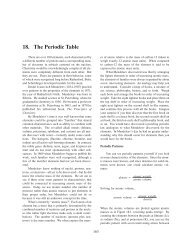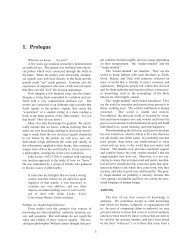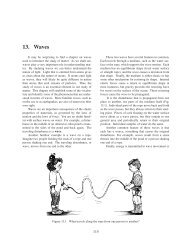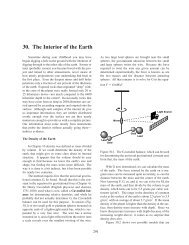Create successful ePaper yourself
Turn your PDF publications into a flip-book with our unique Google optimized e-Paper software.
(a) 19K<br />
(b) 10 Ne<br />
(c) 29Cu<br />
(d) 35 Br<br />
(e) 15P<br />
<strong>20</strong>.8. Write down the primary oxidation states of<br />
the following elements <strong>and</strong> check your answers in<br />
Figure <strong>20</strong>.4:<br />
(a) 5B<br />
(b) <strong>20</strong> Ca<br />
(c) 17Cl<br />
(d) 1 H<br />
(e) 18Ar<br />
(f) 28Ni<br />
(g) 24 Cr<br />
<strong>20</strong>.9. Referring to Figure 18.3, select two atoms<br />
that are likely to have negative oxidation states because<br />
they have very high ionization energies. Avoid the<br />
noble gases 2 He, 10 Ne, <strong>and</strong> 18 Ar. Now look these elements<br />
up in Figure 17.7 to see if there is a vacancy for<br />
an electron in a low-lying orbital.<br />
<strong>20</strong>.10. Referring to Figure 18.3, select two atoms<br />
that are likely to have positive oxidation states because<br />
they have low ionization energies. Now look these elements<br />
up in Figure 17.7 to see if the top electrons are<br />
near the top of the well.<br />
<strong>20</strong>.11. Use Figure <strong>20</strong>.4 to write the common oxidation<br />
states of the following elements (e.g., He: 0; <strong>and</strong><br />
C: –2,0,2, <strong>and</strong> 4):<br />
(a) N<br />
(b) P<br />
(c) O<br />
(d) S<br />
(e) Ne<br />
(f) Ar<br />
<strong>20</strong>.12. From Figure 17.6, state which electron Li is<br />
likely to lose to become Li 1+ . Do the same for Be going<br />
to Be 2+ (two electrons).<br />
<strong>20</strong>.13. How many I – ions will be required to neutralize<br />
the charge on an Al 3+ ion?<br />
<strong>20</strong>.14 How many Al 3+ <strong>and</strong> O 2– ions must be combined<br />
to achieve charge neutralization? (Hint: It will<br />
require more than one of each type of ion.)<br />
<strong>20</strong>.15. Write the chemical formulas for the following<br />
combinations:<br />
(a) K + <strong>and</strong> F –<br />
(b) Na + <strong>and</strong> S 2–<br />
(c) Mg 2+ <strong>and</strong> N 3–<br />
<strong>20</strong>.16. Determine the principal oxidation states of<br />
the following elements <strong>and</strong> then write the correct chemical<br />
formulas for the combinations:<br />
(a) 4Be <strong>and</strong> 35 Br<br />
(b) 31 Ga <strong>and</strong> 8 O<br />
<strong>20</strong>.17. Write the names of the following compounds:<br />
(a) BeO<br />
(b) CaCl 2<br />
(c) LiF<br />
(d) Na 2 S<br />
<strong>20</strong>.18. Write the names of the following compounds:<br />
(a) CrO<br />
(b) CrO 3<br />
(c) Cr 2 O 3<br />
(d) NO 2<br />
(e) SO 3<br />
<strong>20</strong>.19. Complete Table <strong>20</strong>.1.<br />
<strong>20</strong>.<strong>20</strong>. Which of the following is an ionic compound?<br />
(a) O 2<br />
(b) NH 3<br />
(c) CO 2<br />
(d) CH 4<br />
(e) MgF 2<br />
is:<br />
<strong>20</strong>.21. The correct formula for potassium sulfide<br />
(a) KS<br />
(b) K 2 S<br />
(c) KS 2<br />
(d) K 3 S<br />
(e) KS 3<br />
<strong>20</strong>.22. Determine the primary oxidation state for<br />
Rb. If two Rb atoms combine with one S atom, what is<br />
the oxidation state of S?<br />
(a) +2<br />
(b) +1<br />
(c) 0<br />
(d) –1<br />
(e) –2<br />
190








